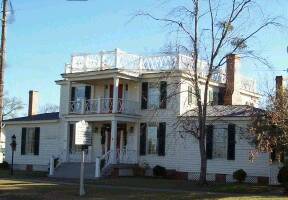Bright, Simon
ca. 1757–1802
 Simon Bright, Revolutionary War soldier, planter, county official, member of the convention that ratified the U.S. Constitution in 1789, and state senator, was born in Johnston County in or about 1757. He was the first son of Simon Bright, Jr., and his wife, Mary Graves. He received his early education under the Reverend William Miller at St. Matthew's Chapel at Kingston (now Kinston). When his father died in December 1776, Simon was a minor; he attained his majority shortly thereafter, in time to become one of the executors of his father's will.
Simon Bright, Revolutionary War soldier, planter, county official, member of the convention that ratified the U.S. Constitution in 1789, and state senator, was born in Johnston County in or about 1757. He was the first son of Simon Bright, Jr., and his wife, Mary Graves. He received his early education under the Reverend William Miller at St. Matthew's Chapel at Kingston (now Kinston). When his father died in December 1776, Simon was a minor; he attained his majority shortly thereafter, in time to become one of the executors of his father's will.
While still a minor, he enrolled in the Dobbs County militia and saw action several times during the Revolution. Late in the war, he volunteered for twelve months' service with the North Carolina state troops, the forces kept under arms in readiness for either state defense or for orders from the Continental establishment. After the war, he continued to serve in the militia of Dobbs County and later of Lenoir County. By 1789 he was held in such high respect by the people of his county that he was elected, with Richard Caswell, Benjamin Sheppard, and Nathan Lassiter, to represent Dobbs County in the convention of 1789. Like other delegates from Dobbs, Bright was an ardent Federalist, holding a viewpoint shared by only the barest majority of the electorate of his county.
In 1790, Bright was sent to the state senate post vacated by the death of Richard Caswell. Disheartened by the political contentions then racking his county he retired to private life. About 1795 he was appointed a justice in Lenoir County; he held the office until the summer of 1799, when he was appointed and served briefly as clerk of the county court, following the death in office of Winston Caswell.
In about 1777, Bright married a woman named Nancy, whose maiden name is not known. To their marriage nine children were born. When Simon died in 1802 in Kinston, his wife and seven of the children survived him, as did a number of grandchildren.
Though a grandfather, Bright was only about forty-five years old when he died. The last two years of his life were burdened with embarrassment, disgrace, and remorse. A criminal act committed by Bright that was incongruent with his existing mannerisms suggested disease in the form of neural decay. On Sept. 11, 1799, Bright was sitting in his parlor visiting with the brothers John and Slade Gatlin. They had been chatting pleasantly for some time when Bright abruptly changed his whole demeanor. He angrily declared, according to depositions made by the Gatlin brothers, "that he had missed two of his Turkeys, and suspected that they were stolen by some Negro and that he would charge his gunn and shoote the first Negro he met with and continue shooting until he killed the right one. Mr. Bright then went off in order to get Powder and Shot to load his Gunn." Shortly thereafter, he waylaid and shot an enslaved woman named Mary. Mary was a highly respected enslaved woman who was enslaved by Captain Jesse Cobb, another justice and the town's leading merchant. The crime shocked the small, close-knit community. Bright was indicted on the criminal charge and prosecuted. During the course of the prosecution his mental condition and general health deteriorated rapidly, resulting in his death before the prosecution could be concluded in the superior court for the New Bern district. His conviction in the county court was later appealed.
Bright was buried at Kinston.
References:
Manuscript records of the Superior Court for the New Bern District, 1760–1808: Simon Bright Estate Papers.
Case Papers in Jesse Cobb v. the Heirs of Simon Bright .
Case Papers in the State v. Simon Bright .
Case Papers in Simon Bright v. Robert White, Sheriff of Dobbs County (North Carolina State Archives, Raleigh).
Additional Resources:
Abstract of North Carolina Wills: Compiled from Original and Recorded Wills in the Office of the Secretary of State. E.M. Uzzell, State Printers, 1910. http://books.google.com/books?id=xRczAQAAMAAJ&dq=simon+bright+1734+unc&source=gbs_navlinks_s&printsec=frontcover#v=onepage&q&f=false (accessed April 16, 2013).
Image Credit:
Harmony Hall, Kinston, NC. Image courtesy of Lenoir County Historical Association. Available from http://www.historicalpreservationgroup.org/HistAssoc/HarHall/ (accessed April 16, 2013).
1 January 1979 | Holloman, Charles R.